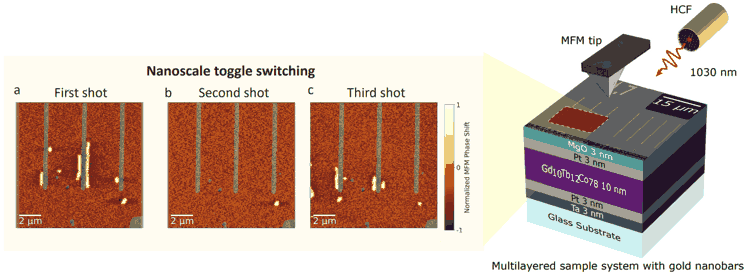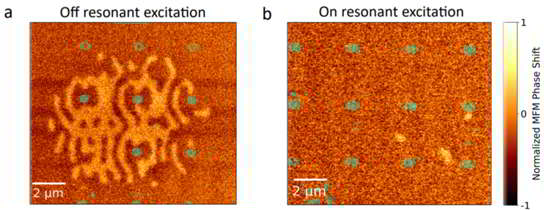From Max Born Institute: Ultrafast Plasmon-Enhanced Magnetic Bit Switching at Nanoscale
Way to control and manipulate nanoscale magnetic bits - building blocks of digital data - using ultrafast laser pulse and plasmonic gold nanostructures
This is a Press Release edited by StorageNewsletter.com on April 25, 2025 at 2:00 pmResearchers from Max Born Institute have demonstrated a successful way to control and manipulate nanoscale magnetic bits — the building blocks of digital data — using an ultrafast laser pulse and plasmonic gold nanostructures.
Fig. 1: Schematic illustration of direct in-situ high-resolution magnetic imaging using MFM.
An ultrashort intense laser pulse is guided through a hollow-core fiber and applied to
plasmonic structures deposited on a magnetic multilayer sample. The change in magnetic state
probed after irradiation of (a) First laser shot focused on the plasmonic nanobars (superimposed in green).
(b) Second laser shot with the same fluence switches the magnetization state back to its original state.
(c) Excitation with the third laser pulse reverses the magnetization state at the edge of the nanobars.
The findings were published in Nano Letters (see below).
All-optical, helicity-independent magnetization switching (AO-HIS) is one of the most interesting and promising mechanisms for this endeavor, where the magnetization state can be reversed between two directions with a single femtosecond laser pulse, serving as ‘0s’ and ‘1s’ without any external magnetic field or complex wiring. This opens up exciting possibilities for creating memory devices that are not only faster and more robust but also consume far less power. Ultrafast light-driven control of magnetization on the nanometer length scale is key to achieve competitive bit sizes in next-gen data storage technology. However, it is currently not well understood to what extent basic physics processes such as heat transfer at the nanoscale and the propagation of magnetic domain walls limit the minimum achievable bit size.
To investigate these open questions, the researchers used plasmonic gold nanostructures, which can confine light to regions smaller than the wavelength of light. These structures were fabricated in-house by electron beam lithography on a 10nm thin film of a magnetic material composed of Rare Earth – Transition Metal alloy (GdTbCo), capable of facilitating small stable magnetic domains due to the presence of the rare earth metal Terbium, generating a large magnetic anisotropy.
Using a 370 fs ultrashort laser pulse of 1030 nm wavelength, magnetic switching was achieved in areas with a width of only 240 nm. The nanostructures also reduced the pulse energies required, due to the enhanced localization of the electromagnetic field around the gold bars, exploiting their plasmonic property.
Illumination with single laser pulses can be used to locally switch the magnetization at the edge of the nanostructure (Fig. 1(a)). Furthermore, a region where the magnetization has been switched by the laser pulse can be reverted with another single laser pulse (Fig. 1(b)) at precisely targeted locations on the magnetic material. It is thus possible to realize a controlled toggling of the magnetization, as required to encode information states ‘0’ and ‘1’. The final magnetic state was visualized using magnetic force microscopy (MFM), a scanning technique that can image the magnetic state of a sample with nanometer scale spatial resolution.
Fig. 2: All optical switching from off- and on-resonant nanodiscs.
In addition to the demonstration of toggle switching, under particular laser pulse conditions the researchers observed interesting extended magnetization patterns as shown in Fig. 2. When exciting under conditions where the nanostructures do not allow for a plasmonic resonance to be excited by the laser, a dipole-like far field scattering domain pattern is ‘imprinted’ in the magnetic film. Via on- and off- resonant plasmonic excitation the dominance of different plasmonic energy transfer mechanisms could be studied.
“While this is basic research on the fundamental processes of localized optical switching of magnetization, it may guide future developments towards optimized excitation schemes in engineered magnetic materials, ultimately allowing to exploit nanoscale control of magnetism using light”, says Puloma Singh, MBI researcher, driving this project together with her MBI colleagues as part of her PhD studies.
Article: Subwavelength Localized All-Optical Helicity-Independent Magnetic Switching Using Plasmonic Gold Nanostructures
Nano Letters has published an article written by Themistoklis Sidiropoulos, Puloma Singh,Tino Noll, Michael Schneider, Dieter Engel, Denny Sommer, Felix Steinbach, Ingo Will, Bastian Pfau, Clemens von Korff Schmising, Max Born Institute for Nonlinear Optics and Short Pulse Spectroscopy, 12489 Berlin, Germany, and Stefan Eisebitt, Max Born Institute for Nonlinear Optics and Short Pulse Spectroscopy, 12489 Berlin, Germany, and Technische Universität Berlin, Institut für Optik und Atomare Physik, 10623 Berlin, Germany.
Abstract: “All-optical, helicity-independent magnetization switching (AO-HIS) is promising for future ultrafast, energy-efficient magnetic data storage. Achieving high bit density requires the reduction of optically addressed magnetic bit sizes at deterministic locations. Metallic nanostructures that support localized surface plasmons enable electromagnetic confinement below the diffraction limit. Rare-earth transition metal alloys like GdTbCo support stable nanometer-sized magnetic domains. We fabricate plasmonic gold nanostructures on a GdTbCo film and demonstrate in situ deterministic toggling of magnetic states through optical excitation using magnetic force microscopy. Imaging the magnetic state with nanometer resolution allows us to observe AO-HIS with a minimum width of 240 nm localized at the edges of plasmonic nanobars following excitation by a single ultrashort laser pulse at 1030 nm. The strong optical field localization via plasmonic nanobars enables reproducible AO-HIS on subwavelength scales. Additionally, high-resolution magnetic imaging highlights differences between the magnetic switching pattern for on- and off-resonant excitation of plasmonic nanodiscs.“
















 Subscribe to our free daily newsletter
Subscribe to our free daily newsletter

